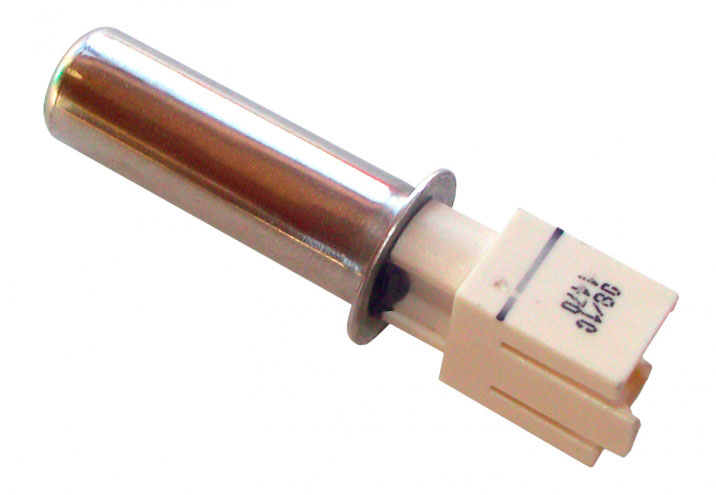 The temperature sensor is one of the main and important elements of the washing machine - it is responsible for heating the water to the desired temperature, and then the temperature sensor turns off.
The temperature sensor is one of the main and important elements of the washing machine - it is responsible for heating the water to the desired temperature, and then the temperature sensor turns off.
If you notice that your washing machine very much "overheats" the water, or on the contrary, in general, it does not heat water at allthen the problem lies in the temperature sensor. In our article, you will learn how to check the temperature sensor for its functionality and for replacement (if it is required).
Variety of temperature sensors
An automatic washing machine can only be equipped with one of the following three temperature sensors:
- Bimetallic;
- Thermistor;
- Gas-filled.
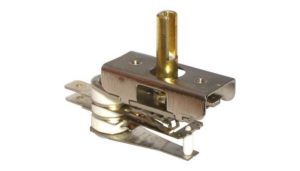 Bimetallic temperature sensor looks like a tablet, about 20-30 millimeters in diameter and 10 millimeters high. Inside this small tablet is a bimetallic plate. During the process of heating water, when it reaches a certain temperature, the plate deflects and creates a contact closure. Under this condition, the heating process is completed.
Bimetallic temperature sensor looks like a tablet, about 20-30 millimeters in diameter and 10 millimeters high. Inside this small tablet is a bimetallic plate. During the process of heating water, when it reaches a certain temperature, the plate deflects and creates a contact closure. Under this condition, the heating process is completed.
The thermistor has become quite a popular element among modern washing designs, which has replaced the temperature sensor.
The thermistor looks like a small elongated cylinder. Its diameter is about 10 millimeters and its length reaches about 30 millimeters. This cylinder is attached directly to the heating element. The principle of operation of such an element does not carry any mechanical work of the part, but simply changes the resistance during the process of heating water to your desired temperature.
Gas-filled temperature sensor has only two parts: the first is a tablet made of metal with a diameter of about 20-30 millimeters and a height of about 30 millimeters.
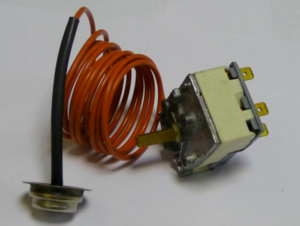 The first part is mainly located inside the tank itself, and always touches the water to change the temperature. The second part of the temperature sensor is in the form of a copper tube, which is connected to the temperature regulator (external), the location of which is on the control panel of the washing machine. Inside these elements there is a gas, the name of which is Freon. Under the temperature of the water, this gas can compress or expand, causing the contacts that lead to the heating element to close and open.
The first part is mainly located inside the tank itself, and always touches the water to change the temperature. The second part of the temperature sensor is in the form of a copper tube, which is connected to the temperature regulator (external), the location of which is on the control panel of the washing machine. Inside these elements there is a gas, the name of which is Freon. Under the temperature of the water, this gas can compress or expand, causing the contacts that lead to the heating element to close and open.
Checking the temperature sensor for proper operation and further replacement
The first step is de-energizing the washing structure. Then the machine needs to be disassembled. The easiest option is to remove the thermistor from the washing machine, which is located inside the heating element. In most of the different models of washing machines from different manufacturers, the heating element is located in the lower (plinth) part.
Perform thermistor removal in four steps:
- Remove the back panel of the washing machine;
- Disconnect the wires from the sensor, which are directed to the temperature regulator (external);
- Slightly loosen the screw that holds the thermistor;
- Remove the thermistor from the device.

Here we have the thermistor in our hands. To test it, you'll need a multimeterwith which we can measure the resistance. Let's go through it step by step:
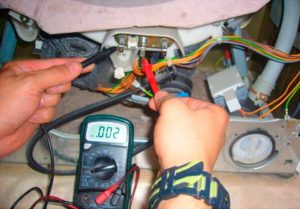 First you need to set the multimeter to measure the resistance;
First you need to set the multimeter to measure the resistance;- Now you need to connect the wires to the contacts of this sensor. (Reference: 20 degrees is about 6000 ohms, or 6kOhms);
- Let's check if the sensor works: Let's drop the sensor into hot water and look at the results on the multimeter. The sensor is functional when the resistance is lower. For example, if the temperature is 50 degrees, the resistance should be about 1350 ohms.
If the temperature sensor does not work, it needs to be replaced, because it can no longer be repaired. Reassemble the construction in the same order as disassembled.
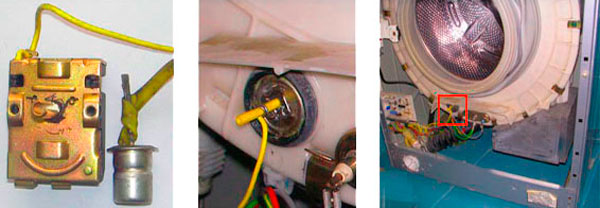 In order to get to the gas-filled temperature sensor, it is necessary to open not only the back panel, but also the front cover (where the control panel is located). This is necessary in order to disconnect the sensor (or rather its external part) from the panel itself.
In order to get to the gas-filled temperature sensor, it is necessary to open not only the back panel, but also the front cover (where the control panel is located). This is necessary in order to disconnect the sensor (or rather its external part) from the panel itself.
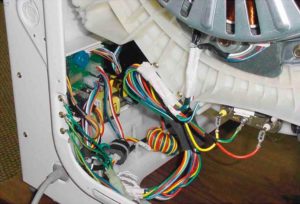 When you have disconnected the external sensor, you need to go back to the back cover, remove it and find the wiring on the body of the tank. Carefully pull off the rubber insulation so as not to damage the copper tubing. You can do this with a thin awl, or a needle. Carefully get under the skin of the rubber band and make a couple of circles to make it easier to tighten the insulation. A little effort while gently pushing on the sensor (press the base, pushing the sensor a little deeper), and it will jump out of the groove on its own. After such action you can safely pull out the temperature sensor through the tank (or rather through the hole in it). Then everything is simple - disconnect the wires and check it with a multimeter.
When you have disconnected the external sensor, you need to go back to the back cover, remove it and find the wiring on the body of the tank. Carefully pull off the rubber insulation so as not to damage the copper tubing. You can do this with a thin awl, or a needle. Carefully get under the skin of the rubber band and make a couple of circles to make it easier to tighten the insulation. A little effort while gently pushing on the sensor (press the base, pushing the sensor a little deeper), and it will jump out of the groove on its own. After such action you can safely pull out the temperature sensor through the tank (or rather through the hole in it). Then everything is simple - disconnect the wires and check it with a multimeter.
As a result, the operation of the sensor becomes impossible. To replace it, proceed as follows. First, buy a new sensor (preferably a kit that also includes a switch) and install it in place of the old one, then assemble everything in the same order.
The bimetal temperature sensor is also difficult to reach, you must also reach it through the tank. Then disconnect the wires from the thermostat.
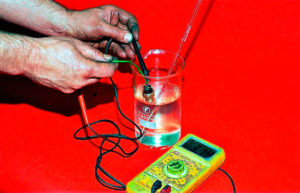
Then connect the pins to a multimeter, and look at the resistance result. Heat the water to a hot temperature and dip the sensor in it - this action is necessary to check the change in resistance. If the resistance drops sharply, the temperature sensor is functional, but if not, it needs to be replaced.
In general, bimetal sensors break because the plate is worn out. In this case, replacing the sensor is very simple, buy a new thermostat (the same one) and install it in place of the old one.
Signs of a broken temperature sensor: the main breakdowns
Here are some basic signs.
- With different washing mode and a certain temperature you selected, the heating element brings the water in the washing machine to a boil;
- During the washing process, the body of the machine gets very hotand steam is coming out of the door.
If your washing machine has such a problem, it is necessary to get rid of it immediately. Otherwise it may burn out your heating element. And do not forget that replacing the heating element is several times more expensive than replacing the temperature sensor.
Replacing the temperature sensor in the washing machine is a fairly easy and simple task, which can be handled by absolutely anyone. You just need to buy exactly the same temperature sensor and put it in place of the old one. We wish you good luck!




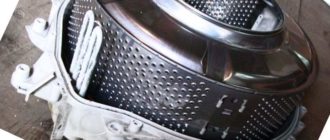
Very useful info.
My washer is not heating the water.
The heating element is fine. Changed to a new one. It only heats at 95 degrees.
The resistance of the old sensor 33,5 kOhm at room temperature. Resistance of the new one is 9,5 kOhm.
LG machine.